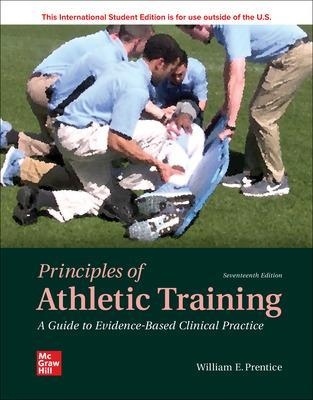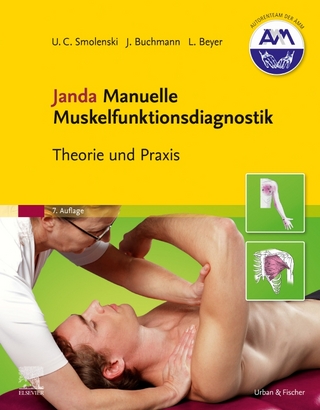
ISE Principles of Athletic Training: A Guide to Evidence-Based Clinical Practice
McGraw-Hill Education (Verlag)
978-1-260-57093-9 (ISBN)
- Titel z.Zt. nicht lieferbar
- Versandkostenfrei innerhalb Deutschlands
- Auch auf Rechnung
- Verfügbarkeit in der Filiale vor Ort prüfen
- Artikel merken
Principles of Athletic Training: A Competency-Based Approach is designed to be used by athletic trainers in courses concerned with the scientific, evidence-based and clinical foundations of athletic training and sports medicine. The text leads the student from general foundations to specific concepts relative to injury prevention, evaluation, management, and rehabilitation. As the student progresses from beginning to end, he or she will understand the complexities of the profession of athletic training. An over-arching goal of the text is to make certain that each and every one of the educational competencies identified by the Education Council is specifically covered. After using this text the student should be able to apply the appropriate techniques and concepts in the day-to-day performance of his or her job as an athletic trainer.
McGraw-Hill Connect® is a subscription-based learning service accessible online through your personal computer or tablet. Choose this option if your instructor will require Connect to be used in the course. Your subscription to Connect includes the following:
• SmartBook® - an adaptive digital version of the course textbook that personalizes your reading experience based on how well you are learning the content.
• Access to your instructor’s homework assignments, quizzes, syllabus, notes, reminders, and other important files for the course.
• Progress dashboards that quickly show how you are performing on your assignments and tips for improvement.
• The option to purchase (for a small fee) a print version of the book. This binder-ready, loose-leaf version includes free shipping.
Complete system requirements to use Connect can be found here: http://www.mheducation.com/highered/platforms/connect/training-support-students.html
Dr. William Prentice is Professor of Exercise and Sport Science and Coordinator of the Sports Medicine Program at the University of North Carolina at Chapel Hill, where he also serves as the Director of the NATA approved Graduate Athletic Training Education Program. He received his BS and MS from the University of Delaware and his Ph.D. in Sports Medicine and Applied Physiology from the University of Virginia. He also has a BS in Physical Therapy from the University of North Carolina. He is a Certified Member of the National Athletic Trainers' Association and has received the Sayers A. "Bud" Miller Distinguished Athletic Trainer Educator Award and the Most Distinguished Athletic Trainer Award from the NATA. In 2004 he was inducted into the NATA Hall of Fame. Dr. Prentice served as the Athletic Trainer for the Women's Soccer Program, which has won eighteen NCAA National Championships. He teaches graduate courses in sports medicine and athletic training. Dr. Prentice is the author of nine best-selling texts in athletic training, sports medicine, and health-related fitness.
PART I: Professional Development and Responsibilities Chapter 1: The Athletic Trainer as a Health Care Provider Historical PerspectivesSports Medicine and Athletic TrainingEmployment Settings for the Athletic TrainerRoles and Responsibilities of the Athletic TrainerReferring the Patient to Other Medical and Nonmedical Support Services and Personnel Recognition and Accreditation of the Athletic Trainer as an Allied Health ProfessionalRequirements for Certification as an Athletic TrainerState Regulation of the Athletic TrainerFuture Directions for the Athletic TrainerSummaryWebsitesChapter 2: Health Care Organization and Administration in Athletic TrainingEstablishing a System for Athletic Training Health CareIssues Specific to Athletic Training Program Operation in the Secondary-School, College, or University SettingIssues Specific to Athletic Training Program Operation in the Clinic, Hospital, Corporate, or Industrial SettingRecord KeepingThe Computer as a Tool for the Athletic TrainerCollecting Injury DataSummary Chapter 3: Legal Concerns and Insurance IssuesLegal Concerns for the Athletic TrainerInsurance ConsiderationsThird-Party ReimbursementSummaryWebsitesPART II: Risk ManagementChapter 4: Fitness and Conditioning TechniquesThe Relationship between Athletic Trainers and Strength and Conditioning CoachesPrinciples of ConditioningWarm-Up and CooldownCardiorespiratory EnduranceThe Importance of Muscular Strength, Endurance, and PowerImproving and Maintaining FlexibilityFitness AssessmentPeriodization in ConditioningSummaryWebsitesChapter 5: Nutrition and Supplements Nutrition BasicsEnergy SourcesRegulator NutrientsNutrient Requirements and RecommendationsDietary SupplementsEating and Drinking PracticesGlycogen SupercompensationBody Composition and Weight Control Summary WebsitesChapter 6: Environmental Considerations Hyperthermia HypothermiaAltitudeOverexposure to SunLightning SafetyAir PollutionCircadian Dysrhythmia (Jet Lag)Synthetic TurfSummaryWebsitesChapter 7: Protective Equipment Safety Standards for Sports Equipment and FacilitiesLegal Concerns in Using Protective EquipmentEquipment Reconditioning and RecertificationUsing Off-the-Shelf versus Custom Protective EquipmentHead ProtectionFace ProtectionNeck ProtectionTrunk and Thorax ProtectionLower-Extremity Protective EquipmentElbow, Wrist, and Hand ProtectionConstruction of Protective and Supportive DevicesSummaryWebsitesChapter 8: Wrapping and TapingWrappingNonelastic and Elastic Adhesive TapingCommon Taping ProceduresKinesio TapingSummaryWebsitesPART III: Pathology of Sports InjuryChapter 9: Mechanisms and Characteristics of Musculoskeletal and Nerve TraumaMechanical InjuryMusculotendinous Unit InjuriesSynovial Joint InjuriesBone InjuriesNerve TraumaBody Mechanics and Injury SusceptibilitySummaryWebsitesChapter 10: Tissue Response to InjuryThe Healing ProcessSoft-Tissue HealingBone HealingPainSummaryWebsitesPART IV: Management SkillsChapter 11: Psychosocial Intervention for Sports Injuries and IllnessesThe Psychological Response to InjuryThe Athlete and the Soci
| Erscheinungsdatum | 29.04.2020 |
|---|---|
| Zusatzinfo | 221 Illustrations |
| Verlagsort | OH |
| Sprache | englisch |
| Maße | 257 x 2304 mm |
| Gewicht | 1964 g |
| Themenwelt | Medizin / Pharmazie ► Medizinische Fachgebiete ► Sportmedizin |
| Wirtschaft ► Betriebswirtschaft / Management | |
| ISBN-10 | 1-260-57093-2 / 1260570932 |
| ISBN-13 | 978-1-260-57093-9 / 9781260570939 |
| Zustand | Neuware |
| Informationen gemäß Produktsicherheitsverordnung (GPSR) | |
| Haben Sie eine Frage zum Produkt? |
aus dem Bereich


